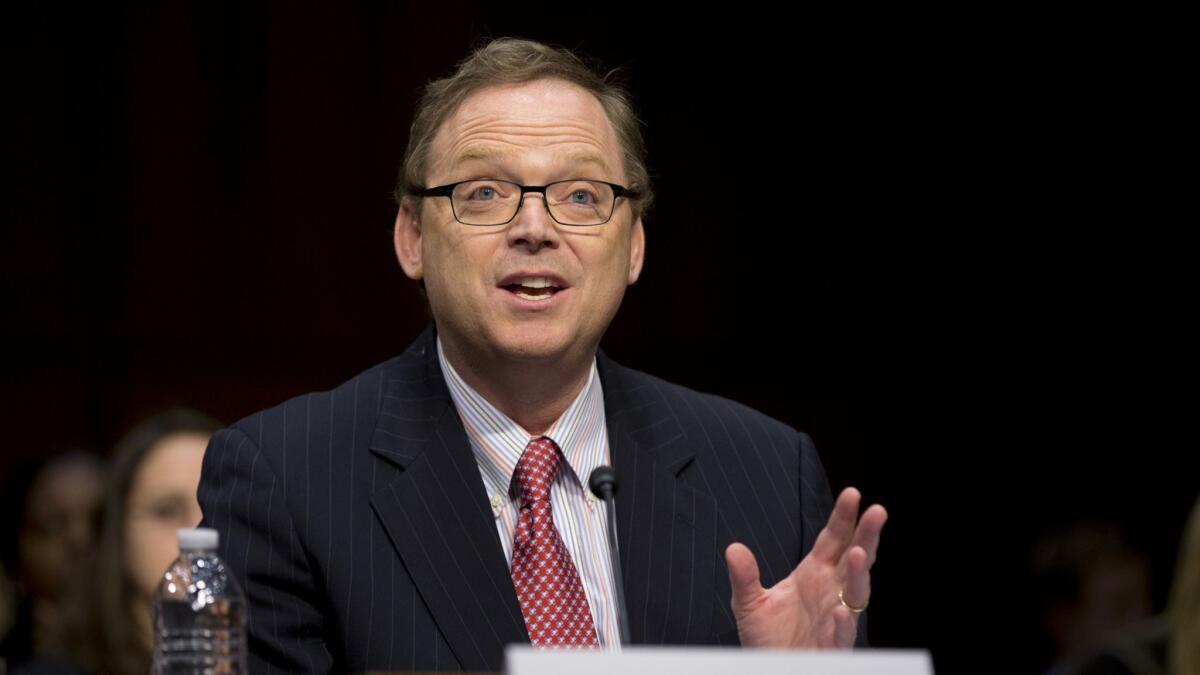Column: Trumpâs dream of better than 3% economic growth recedes again

Even before Fridayâs release of the economic growth number for the first three months of 2018, economists and market watchers were trying to explain away what they expected to be a grim number.
The consensus figure of 2.0% may have overestimated just how grim. The growth of 2.3% over the same period a year ago may not have been grim, but certainly was dismal.
More to the point in political terms, it underscored just how hard it will be to reach President Trumpâs promise of annual growth better than 3% â much less the prediction of his Treasury secretary, Steven T. Mnuchin, of 4% or better. As weâve written before, those goals arenât necessarily unachievable, but theyâre not the way to bet.
The figure also hints at the downside of prematurely declaring victory, which is that real life sometimes interferes with the celebration. Just 10 days ago Kevin Hassett, President Trumpâs chief economist, was proclaiming that the Republican tax cuts already had created a âdynamic, competitiveâ U.S. economy.
Not so fast, Dr. Hassett. The statistics released Friday by the Bureau of Economic Analysis showed that, while business investment was strong, consumer spending slowed and imports increased. Put them together, and the growth rate cooled from the last three quarters of 2017, when it came in at 3.1%, 3.2%, and 2.9%.
Itâs true that tracking quarterly GDP figures is something of a mugâs game. The statistic can be volatile, often skewed by seasonal quirks. Thatâs especially true of the first-quarter figure, which appear to have understated the real condition of the economy for a few years running, for reasons no one seems able to put their fingers on. Moreover, the quarterly figures are due to be revised twice over the next couple of months before theyâre final, although the revisions seldom change the first estimate by more than a few tenths of a percentage point.
But that doesnât keep pundits and politicians from harping on the numbers to support their own ideological goals. Trumpâs minions consistently have pointed to the quarterly figures to argue that his economic policies, such as they are, have set the stage for stronger growth. When the growth doesnât show up, as has been the case over the last sixth months, they promise that itâs just over the horizon.
Thatâs the case with chief economist Hassett, who wrote in the Wall Street Journal on April 17 that the tax cuts are turbocharging corporate profits and that âwhen profits go up, capital investment goes up, and wages follow.â
That may be true as a Platonic ideal, but the evidence thus far is that the benefit of the tax cuts is flowing chiefly to shareholders in the form of stock buybacks and increased dividends, while workers receive one-time bonuses but not long-term wage increases. Hassettâs skills as an economic prognosticator are suspect, anyway â heâs the co-author of the 1999 book âDow 36,000,â which predicted the widely watched industrial index would reach that milestone within a few years. Instead, it fell from the 10,000-11,000 range in 1999 to below 8,000. As of today, nearly 20 years later, it still hasnât reached the bookâs target.
Thatâs not to relitigate the folly of the book, but as a reminder of what A.J. Liebling called âthe futility of flapdoodle.â Trumpâs prediction during the 2016 presidential campaign that his election would bring about annual economic growth of 3.5% or even 4% was nothing but political sloganeering, utterly divorced from economic reality. As we observed nearly a year ago, structural factors within the U.S. economy, including already-low unemployment, a long-term decline in productivity, and rising income and wealth inequality may be headwinds holding back economic growth. Trumpâs policies havenât reversed any of those factors and may have made the third one even worse. The current U.S. expansion will soon become the second-longest on record; that raises the prospect that a recession could be looming.
As for the tax cuts, economists believe that they may goose economic growth through the rest of 2018, but that a hangover will begin to show up in later years as federal deficits and interest rates rise.
Holdouts for the notion that annual growth of 3%-plus may still be in the offing point out that the first-quarter economy was affected by a few unusual circumstances, such as heavy consumer spending in late 2017 on repair and replacement of hurricane-damaged property , which left consumers tapped out in the first quarter.
But most people who follow economic trends knows that thereâs always something affecting quarter-to-quarter changes. The thing to watch is the longer trend, and signs are just beginning to emerge that the long expansion may be running out its string.
Keep up to date with Michael Hiltzik. Follow @hiltzikm on Twitter, see his Facebook page, or email [email protected].
Return to Michael Hiltzikâs blog.
More to Read
Inside the business of entertainment
The Wide Shot brings you news, analysis and insights on everything from streaming wars to production â and what it all means for the future.
You may occasionally receive promotional content from the Los Angeles Times.











